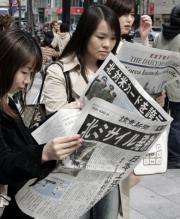Giants of Japanese media eye digital salvation

With huge circulations, loyal readers and a tireless reporting culture that runs around the clock, Japan's newspapers have defied many of the woes that have beset their western print peers.
But a crisis of shrinking revenues is looming as Japan's dailies scramble to make their online editions profitable, attract a new generation of readers in an ageing society and avoid the woes of US and European titles.
Advertising spending has plunged 42 percent in the past decade, exacerbated by a global downturn that hammered the Japanese economy, threatening to make negative headlines out of print media's bottom lines.
"Newspapers are seeing a crisis coming," said Shinji Oi, professor at Nihon University.
"Japan has yet to see the major newspaper bankruptcies and financial troubles that we have seen in the West. But newspapers' business fundamentals are definitely deteriorating," he said.
The Japanese newspaper industry has seen circulation slip only six percent in the ten years to 2009, with the top-selling Yomiuri Shimbun newspaper boasting the world's biggest of more than 10 million copies daily.
And newspapers remain the preferred source of news in Japan, with circulation standing at a robust 50.4 million daily sales in 2009, according to the Japan Newspaper Publishers & Editors Association.
With home-delivery subscription strong, armies of sales staff are always on the lookout for potential new subscribers, offering laundry detergent or tickets to sports games as gifts to new customers.
Demand for fresh news is met with constantly updated editions throughout the day, with so-called "yomawari" (night watch) reporters doorstepping senior figures until the early hours to generate fresh headlines for their morning editions.
Advertising revenue, which can be volatile particularly during slow economic times, accounts for roughly 30 percent of their income.
But an apparent failure to capture a younger generation that grew up with the Internet and the concept of free, up-to-the-minute news could prove costly in a greying society.
People in their 20s generally view newspapers as expensive and time-consuming media that include unnecessary information and can be replaced by free alternatives, according to think tank M1F1 Research Institute.
A separate survey by the Japan Press Research Institute found that most people under 40 regarded an average 40-dollar monthly newspaper subscription fee as too expensive.
Meanwhile a perceived deterioration of quality in pursuit of sensationalism has disappointed readers, said Takaaki Hattori, media law professor at Rikkyo University.
Serious journalism was costly and Japanese media had sought to cut editorial spending at the expense of quality reporting, Hattori said.
He added that a crisis that saw "two or three major papers folding" would actually be a good thing for an industry veering towards complacency. "Then, the industry may find ways to rebuild itself," he said.
Such a process is underway in the United States, where a reliance on ailing advertising revenues sounded the death knell for many titles as the economy soured in response to the subprime mortgage crisis and entered recession.
The Tribune Co. the owner of the Chicago Tribune, Los Angeles Times and other newspapers filed for bankruptcy protection in December 2008, a status it is currently working to exit from.
But in July The Times Co., which owns The Boston Globe, International Herald Tribune and other newspapers in addition to the flagship New York Times, reported double-digit growth in digital advertising to offset a continued slide in print advertising.

Yet major Japanese media have shied away from establishing full-blown Internet editions as they have failed to profit from such ventures due to reader resistance to pay for news amid falling advertising revenues.
The Japanese language also limits the international market value of their sites, unlike US and British media that can serve English speakers around the world, say analysts.
Gadgets such as the iPhone and iPad have encouraged the wider public to read news for free, with consumer spending soft in the wake of Japan's protracted economic slowdown since the early 1990s.
Domestic news media have taken a wait-and-see approach to devices such as the iPad when it comes to tailoring applications for the Japanese market, but now titles such as the Nikkei and the Sankei Shimbun have launched apps.
At the vanguard is the Nikkei business daily, which became the first major Japanese paper to launch a full-scale online edition, featuring free and paid-content sections with stories and analysis.
Since its launch in late March, the online Nikkei has acquired roughly 440,000 subscribers, including some 70,000 paid readers by July.
The readership is only a tiny fraction of the paper edition's 3.0 million circulation.
"We think it will be difficult to go with the paper edition alone," said Kiyoshi Noma, deputy managing director of the Nikkei's online business.
"With the web edition co-existing with the printed edition, we may be able to create a new business model," he said, adding that readers are willing to pay for quality information -- online or not.
"We are not in a rush. We will take things slowly to build it as a stable business," he said.
Mainstream newspapers should redesign themselves to serve a targeted readership instead of a mass audience to improve financial stability, said professor Oi of Nihon University.
"It is becoming increasingly difficult to capture all readers," Oi said. "Readership behavior is changing. Japanese media must diversify."
(c) 2010 AFP




















